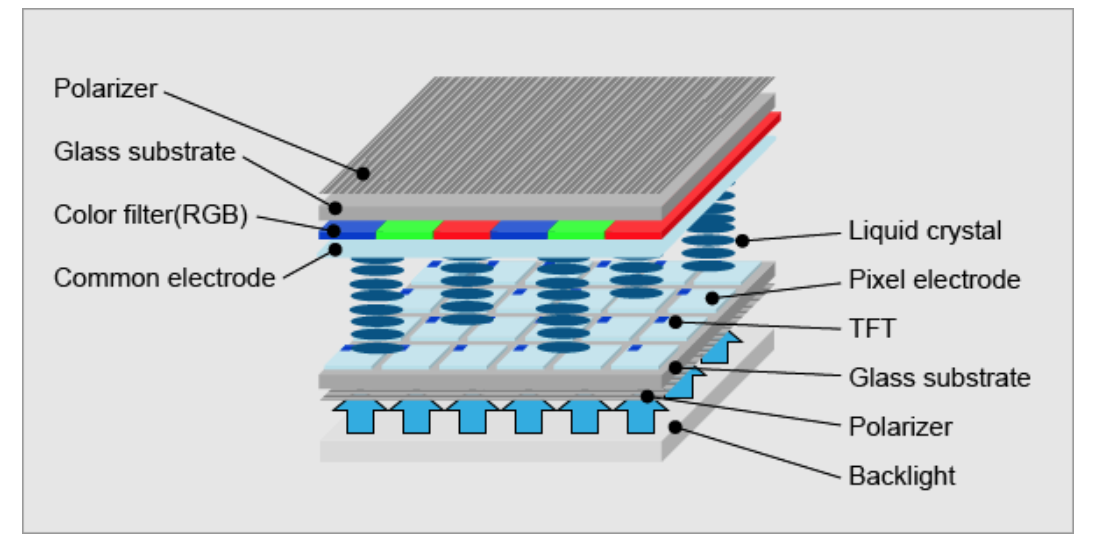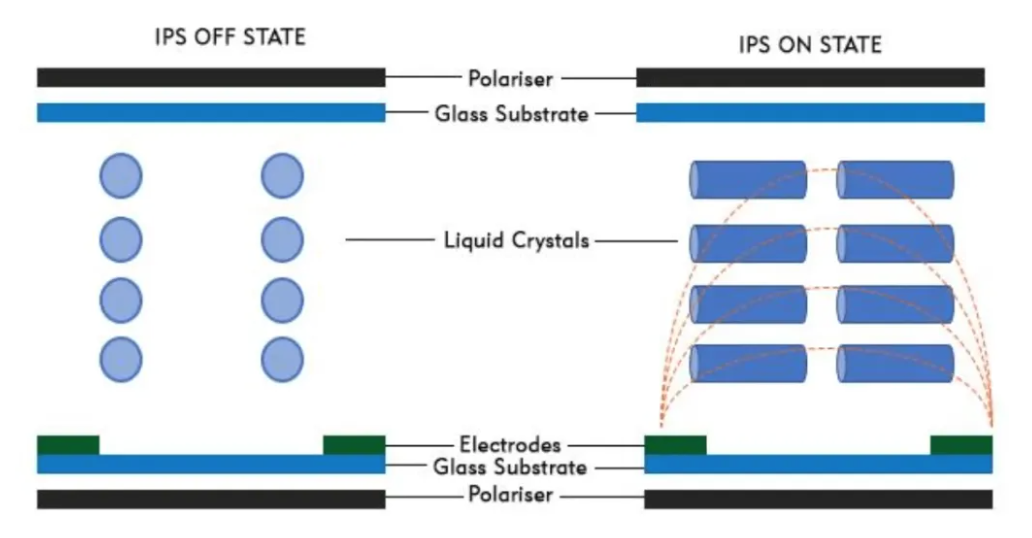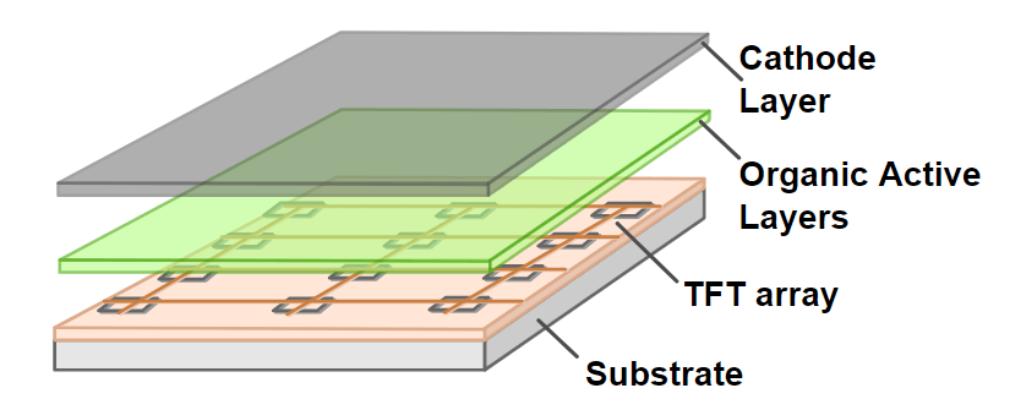
Display technologies are always in progress. Your laptop might use a normal TN TFT (Twisted Nematic Thin Film Transistor) LCD technology with poor viewing angle and contrast. Recent years, display companies invested billions of dollars to develop and manufacture better display technologies to give people better contrast, speed, color, power etc. The battle ground in the most elite display technologies is most at the cell phone, laptop and TV market which the people are willing to pay more for their daily usage. LCD, IPS TFT and OLED are the mainly rivals in the market.
LCD
Generally, LCDs are known as the “backlight displays” because the pixels on the display are powered by a polarized light engineered to the screen. The light passes through the (horizontal and vertical) filters which help determine the pixel’s brightness. Although the inclusion of a backlight makes LCD displays (and phones) thicker, pixels are generally more closely packed, colours are more natural, and images — sharper.
LCD displays are further categorised into two types on the basis of the technology used to make them. The two types are IPS LCD and TFT LCDs.
TFT LCD
TFT stands Thin-film Transistor and de facto, it really isn’t a type of display. TFT is only the technology used to produce LCD display panels. TFT LCD displays use an ‘Active Matrix Technology” where the display transistor and capacitor have individual pixels attached to them. In fact, each pixel can have as many as four transistors; for switching them off and on easily. TFT displays are widely known for having high contrast ratios, resolution and image quality. They are also cheaper to produce but not as cheap as IPS LCD.

IPS LCD
IPS stands for In-Plane Switching and it is the most popularly used type of LCD panels for a number of reasons. First, compared to TFT, the crystal/pixel orientation on IPS LCD is different. This modification allows for improved colour reproduction, better viewing angles, and reduced energy consumption. This is why IPS LCD is preferred over TFT by most gadgets manufacturers.

OLED
OLED stands for “Organic light-emitting diode”. Unlike LCD displays, OLED panels produce their own light and do not rely on a backlight. This self-emission is achieved when an electrical current passes through two conductors with an organic carbon-based film between them.
For every pixel in an OLED panel, this light emission process takes place, except when black is being displayed; the pixels are turned off instead. This makes OLED the best display that shows true black colour. The process of turning off pixels when displaying black is also a battery-wise feature of OLED panels.
Regarding quality, OLED are generally better at displaying blacks. They are also slimmer, dissipate less heat, and possess better contrast ratio when compared to LCDs. However, they are more expensive to produce and in turn lead to an increase in the price of smartphones they are used on. Shorter lifespan is also a downside to OLED displays.
AMOLED
AMOLED is an advanced type of OLED display that uses an “Active Matrix” technology. AMOLED is the acronym for Active Matrix Organic Light Emitting Diode (AMOLED). Like OLED, AMOLED pixels also emit their own light and further uses an active matrix system attached to a thin-film transistor (TFT) to exert more control over each pixels. This results to better visual experience; darker blacks, deeper brights, and higher refresh rates.
AMOLED panels are mostly used in big-sized smartphones as it supports almost any display size. One downside to AMOLED panels, though, is poor usability under sunlight.

Super AMOLED
Also called S-AMOLED, Super AMOLED is an upgrade of AMOLED panels. Unlike regular AMOLED, this upgrade uses almost the same technology but with architectural modifications that makes it better. In S-AMOLED, the touch sensor component have been integrated with the screen; both are separated in regular AMOLED.
This difference results in brighter display, reduced power consumption, reduced sunlight reflection, enhanced outdoor readability, and wider viewing angles. Super AMOLED is one the best displays out there and can be found on many flagship devices like the Samsung Galaxy A7 (2018) with three rear cameras, Samsung Galaxy Note9.
LCD
Generally, LCDs are known as the “backlight displays” because the pixels on the display are powered by a polarized light engineered to the screen. The light passes through the (horizontal and vertical) filters which help determine the pixel’s brightness. Although the inclusion of a backlight makes LCD displays (and phones) thicker, pixels are generally more closely packed, colours are more natural, and images — sharper.
LCD displays are further categorised into two types on the basis of the technology used to make them. The two types are IPS LCD and TFT LCDs.
TFT LCD
TFT stands Thin-film Transistor and de facto, it really isn’t a type of display. TFT is only the technology used to produce LCD display panels. TFT LCD displays use an ‘Active Matrix Technology” where the display transistor and capacitor have individual pixels attached to them. In fact, each pixel can have as many as four transistors; for switching them off and on easily. TFT displays are widely known for having high contrast ratios, resolution and image quality. They are also cheaper to produce but not as cheap as IPS LCD.

IPS LCD
IPS stands for In-Plane Switching and it is the most popularly used type of LCD panels for a number of reasons. First, compared to TFT, the crystal/pixel orientation on IPS LCD is different. This modification allows for improved colour reproduction, better viewing angles, and reduced energy consumption. This is why IPS LCD is preferred over TFT by most gadgets manufacturers.

OLED
OLED stands for “Organic light-emitting diode”. Unlike LCD displays, OLED panels produce their own light and do not rely on a backlight. This self-emission is achieved when an electrical current passes through two conductors with an organic carbon-based film between them.
For every pixel in an OLED panel, this light emission process takes place, except when black is being displayed; the pixels are turned off instead. This makes OLED the best display that shows true black colour. The process of turning off pixels when displaying black is also a battery-wise feature of OLED panels.
Regarding quality, OLED are generally better at displaying blacks. They are also slimmer, dissipate less heat, and possess better contrast ratio when compared to LCDs. However, they are more expensive to produce and in turn lead to an increase in the price of smartphones they are used on. Shorter lifespan is also a downside to OLED displays.
AMOLED
AMOLED is an advanced type of OLED display that uses an “Active Matrix” technology. AMOLED is the acronym for Active Matrix Organic Light Emitting Diode (AMOLED). Like OLED, AMOLED pixels also emit their own light and further uses an active matrix system attached to a thin-film transistor (TFT) to exert more control over each pixels. This results to better visual experience; darker blacks, deeper brights, and higher refresh rates.
AMOLED panels are mostly used in big-sized smartphones as it supports almost any display size. One downside to AMOLED panels, though, is poor usability under sunlight.

Super AMOLED
Also called S-AMOLED, Super AMOLED is an upgrade of AMOLED panels. Unlike regular AMOLED, this upgrade uses almost the same technology but with architectural modifications that makes it better. In S-AMOLED, the touch sensor component have been integrated with the screen; both are separated in regular AMOLED.
This difference results in brighter display, reduced power consumption, reduced sunlight reflection, enhanced outdoor readability, and wider viewing angles. Super AMOLED is one the best displays out there and can be found on many flagship devices like the Samsung Galaxy A7 (2018) with three rear cameras, Samsung Galaxy Note9.







